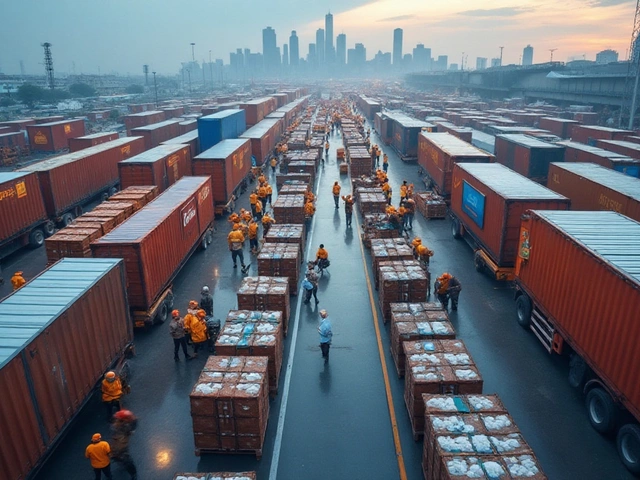Ever thought about sending a letter to Aunt Clara in Auckland or a postcard to your best friend who moved to Tokyo? Sending regular mail across borders is not as rare as it used to be, and thanks to global postal services, it’s pretty doable! But if you’ve never done it before, you might have a few questions.
First things first—most postal services around the world have an international mailing option. You just need to drop by your local post office, and they'll be happy to help. But there’s more to it than just slapping a stamp on your letter. You’ll need to figure out the right weight, postage cost, and, in some cases, fill out a customs form.
Got a package instead of a letter? Make sure to pack it securely, because your parcel will travel thousands of miles. Packaging it well protects it from getting damaged as it hops from truck to plane and back. Simple spaces like rolls of bubble wrap or tightly packed padding can do wonders for heavier items.
- Understanding International Postal Services
- How to Prepare Your Mail
- Costs and Delivery Times
- Navigating Customs Declarations
- Common Mistakes to Avoid
- Fun Facts and Interesting Tidbits
Understanding International Postal Services
So, you’re ready to send your international shipping? Let’s break down how regular mail makes its way from your home country to somewhere far away. For starters, the postal service in your country, like USPS in the United States or Royal Mail in the UK, has agreements with postal services in other countries. These agreements help them handle each other's mail.
Postal Categories
When sending regular mail abroad, you often have a few options. Normally, it comes down to speed versus cost. You could take the budget route with standard mail, which is cheaper but takes longer, or you might go for faster priority services that are quicker but cost more.
Some countries even offer special services like tracking for regular mail. This extra peace of mind means you can follow your item as it journeys across the globe.
The Process
Once your mail leaves your hands, it first goes through processing centers in your country before heading to an international hub. From there, it's sorted based on the destination and put on a flight to the receiving country. After landing, it hits local sorting facilities and is delivered through the standard post system.
Popular Postal Services and Their Reach
Services like DHL, UPS, and FedEx also offer international services in addition to national postal operators. They’re often faster but at a premium. They handle everything from small letters to large packages, making them versatile for different needs.
An interesting fact? The Universal Postal Union, a UN agency, coordinates these international postal efforts, ensuring mail can be sent to even the most remote parts of the world.
What To Check Before Sending
- Make sure your address and recipient’s address are correct and legible.
- Check size and weight limits for mail, as they differ by destination.
- Verify if the destination country has restrictions on certain items, like electronics or food, before mailing.
By understanding these basics, you set your international mail up for success, ensuring it arrives safely wherever it needs to go. And who knows, maybe you’ll even get something surprising back from wherever it ends up!
How to Prepare Your Mail
Ready to send mail across the globe? Awesome! But let's make sure it's prepared perfectly so it doesn't get lost in the sea of letters and packages.
1. Choosing the Right Envelope or Box
Start with the basics—pick an envelope for letters or a box for packages that can withstand the journey. Regular envelopes work for light paper items, but if you’re sending something fragile or bulky, opt for a sturdy box.
2. Packaging Properly
Got something to ship? Pack it securely to keep it safe during transit. Use bubble wrap for fragile items, and fill empty spaces with packing peanuts or crumpled newspapers. Make sure there aren’t any loose parts moving around.
3. Weigh and Measure Your Mail
Before heading to the post office, check the weight and dimensions of your mail. This affects postage costs. Most postal services have a weight limit for international shipping—better safe than sorry!
4. Addressing the Package
Put the recipient’s address clearly on the front and your return address at the top-left corner. Use permanent ink—smeared instructions won't help anyone. For international addresses, don't forget to write the country in capital letters at the bottom.
5. Filling Out Customs Forms
Mailing a parcel? You'll need to fill out a customs form. This form declares what's inside your package and its value. You can usually get these forms at your local post office or fill them out online.
| Country | Customs Form Requirement |
|---|---|
| USA | Yes |
| UK | Yes |
| Germany | No for letters, Yes for packages |
Proper preparation saves time and headache—making sure your regular mail travels smoothly to its international destination. Now you’re set to drop that package off at the postal counter with confidence!
Costs and Delivery Times
So, you've got your international mail ready, but how much will it cost, and how long will it take? The answers can vary a lot depending on where you're sending your letter or package and how fast you want it to arrive. Let's break it down.
Understanding Costs
International shipping costs broadly depend on the size and weight of your mail. Smaller, lighter items will cost less than hefty parcels. Many postal services offer calculators online to help you figure out the exact postage.
- For example, sending a standard letter from the U.S. to Canada might only set you back around $1.50. But pop that letter over to Australia, and you're looking at closer to $2.75.
- Larger packages can range from $15 to even $70+ depending on the destination and the weight!
Another thing to consider is the service speed. Most postal services offer several shipping options, from standard to priority or express services, each with its price tag.
Delivery Times
Now, the big question: how long will it take for your mail to get there? It largely depends on the country and the service you choose.
- A standard international delivery might take anywhere between 7 to 21 days.
- Priority services are quicker, often delivering within 6 to 10 days.
- Need it there REALLY fast? Express services can promise delivery in 3 to 5 working days, but this comes at a premium.
To give you a sense of how delivery times might compare across various regions, here's a quick cheat sheet:
| Destination | Standard (days) | Priority (days) | Express (days) |
|---|---|---|---|
| Europe | 7-14 | 5-7 | 3-5 |
| Asia | 10-21 | 7-10 | 3-5 |
| South America | 14-21 | 10-14 | 5-7 |
| Africa | 14-28 | 7-10 | 3-5 |
Considering these options helps tailor your choice depending on urgency and budget.

Navigating Customs Declarations
Customs declarations might seem a bit intimidating at first, but they’re crucial when it comes to international shipping. Why? Because they let customs officials in the receiving country know what’s in your package and if any duties or taxes apply. Think of it as giving your mail a passport.
So, what exactly do you need to fill out? If you're sending a letter with just paper, you might not need a declaration. But anything else, like a gift or merchandise, will usually need a form. In most countries, this is often referred to as a CN22 or CN23, depending on the package's value.
What Information to Include
When filling out the customs form, you must provide accurate details. This includes a description of the contents, the value of each item, and their weight. Be honest—declaring “socks” but actually shipping a smart gadget won’t cut it. Authorities can open parcels to verify their contents, so transparency is key.
You’ll also need to mark if the item’s a gift, commercial sample, or merchandise. This classification helps determine any duties or taxes that might need to be paid when it reaches its destination.
Tips for a Smoother Process
- Always double-check the destination country’s import policies. Some items might be restricted or outright banned.
- If you’re sending valuable items, consider insurance.
- List the value in the local currency of the destination to avoid confusion.
Want to know how different countries handle customs? Here's a quick glimpse:
| Country | Average Import Fee |
|---|---|
| USA | 5% - 10% |
| Australia | 10% GST |
| Germany | 19% VAT |
Remember, customs isn't there to slow you down. It’s a way to keep track of goods moving across borders and protect countries' economic interests. By following the right steps, you can make sure your mailing experience is as smooth as possible.
Common Mistakes to Avoid
It's easy to make a blunder when you’re new to sending international mail. But guess what? They're mostly avoidable with a bit of prep. Here’s what to watch out for:
Wrong or Incomplete Address
This one’s a biggie. Ensure your address is accurate and complete. Different countries have different address formats, so make sure you get it right. Missing a zip code or a street number could mean your mail takes a longer journey back to you instead of reaching its destination.
Incorrect Postage
Underpaying or overpaying postage is more common than you might think. Use your local post office's weight scale or a trusted app to get the correct postage. Overpaying isn’t a disaster, but underpaying might result in your mail getting returned.
Ignoring Customs Forms
Sending a letter? No customs forms needed. But if you’re mailing a package internationally, this isn’t something to skip. Fill out the forms at the post office or online to avoid delays. Don’t lie or omit info—customs take these things seriously.
Poor Packaging
Got something fragile? Crumpled paper alone won’t cut it. Ensure your items are well-protected, using bubble wrap or industrial packing peanuts if necessary. It’s also crucial to use a sturdy box, especially for packages going thousands of miles.
Forgetting the Label
Easily overlooked, especially if you’re in a hurry. Make sure your label is clear, visible, and attached firmly. If it falls off mid-transit, your mail could end up in postal limbo.
Avoiding these common mistakes can save you a lot of headaches down the line, making your international shipping experience as smooth as butter.
Fun Facts and Interesting Tidbits
Did you know that global international shipping isn’t an entirely modern phenomenon? Ancient civilizations routinely sent messages and packages across lands, albeit with much slower delivery times. Today, things are quicker, but still just as interesting!
Oldest Postal Service in the World
The world's oldest operating postal service is in San Marino. It dates back to 1607! Talk about mail with a history!
Most Expensive Destinations
Sending regular mail to the tiny island of Tuvalu can cost a pretty penny. Why? Due to its remote location, getting mail there involves a long journey.
Track Your Mail From Almost Anywhere
Thanks to modern technology, you can track your international mail from virtually any corner of the world. Many postal services now offer online tracking. Just keep the tracking number handy.
Global Stamp Enthusiasts
Philately, or stamp collecting, remains a beloved hobby worldwide. Some collectors are especially fond of stamps from rare international shipping destinations.
Fun Postal Stats
| Country | Average Delivery Time (Days) |
|---|---|
| USA to Canada | 5-10 |
| UK to Australia | 7-14 |
| Germany to Japan | 10-12 |
It's fascinating how something as simple as sending mail can connect us all globally. Every letter you send contributes to a rich tapestry of international communication, bridging gaps across cultures and distances. So, next time you pop a letter in the mail, remember it's part of a vast network with a dynamic history.





